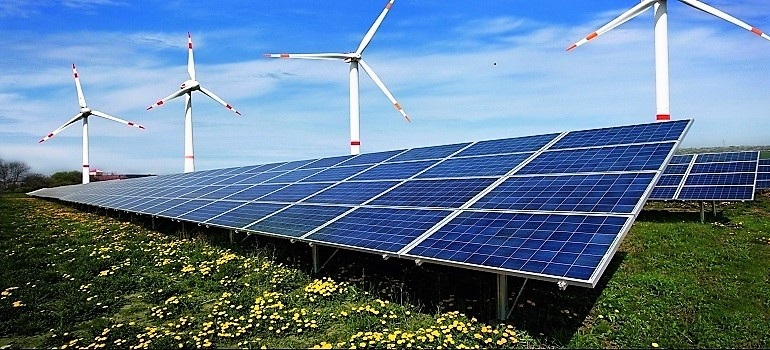 People in Germany’s small towns and rural areas are turning to renewable energy in a process that has special lessons for countries like India.
People in Germany’s small towns and rural areas are turning to renewable energy in a process that has special lessons for countries like India.
Learning how Germany’s citizen-owned, highly-decentralised energy transition, named Energiewende, is working to decarbonise the economy, could be most useful for India, the third-biggest solar installer after China and the US, and aiming to increase its solar capacity to 100 GW by 2022.
This is a new business model for sustainable growth to limit manmade climate change along with strengthening regional purchasing power, said policymaker Peter Heck.
“Energiewende means spending our money in regional business circles rather than sustaining the profit of international oil giants,” Heck, who is the Managing Director with the Institute for Applied Material Flow Management in Trier University of Applied Sciences, told IANS.
Since the energy transition set off in 2000, tens of thousands in the world’s fourth-largest economy have turned into electricity entrepreneurs, investing in solar panels on their houses and buying shares in wind turbines.
Engaging people even in small cooperatives has become a mass movement to favour energy transition from fossils to renewable sources despite rising electricity prices, protests against wind parks and the rising renewables surcharge.
“We made our dream come true with the linking of a photovoltaic system on the roof of the community hall with a battery storage system to supply the LED streetlights in the whole village,” Horn Mayor Volker Harter told IANS during a recent visit to citizen-owned renewable energy installations in the Hunsruck region in Rhineland-Palatinate.
Likewise, a solar thermal plant supplies the entire Neuerkirch municipality with heat.
Rhineland-Palatinate State Energy Agency Executive Director Thomas Pensel said the state is the front-runner in fulfilling its commitment under the Paris Climate Change Agreement through a full-scale social and economic transformation by cutting greenhouse gas emissions with ending fossil fuels’ use.
Sample this bright vision of a bottom-up energy revolution in Rhineland-Palatinate, a pioneer in the development of renewable energies through 42 citizen energy cooperatives, which has turned into a big business.
Prominent among them is the SOLIX cooperative based in the municipality of Warrstadt, which, in 2007 and 2010, began installing solar panels on the roofs of municipal buildings. Their success encouraged Petra Gruner-Bauer and seven others to establish SOLIX, which by 2016, had 115 individual members as well as four regional shareholders, comprising three local companies.
SOLIX now owns and operates a 50 KW photovoltaic plant as well as a three MW wind turbine that supplies electricity to around 5,000 people per year.
The cooperative currently accepts members who acquire shares worth a minimum of 1,000 euros and up to 50,000 euros. The total volume of shares was more than one million euros at the end of 2016.
As per German laws, all members of a cooperative have equal voting rights, regardless of their financial contribution.
“A lot of communities have been successful pioneers to earn money with the expansion of renewable energies,” said State Ministry of Environment and Energy Secretary Thomas Griese.
He said currently 48 percent of the power production in the state is based on renewable sources and 70 per cent of the power is produced in Rhineland-Palatinate itself.
Mainz-based UrStrom, founded in 2010, is an example for the potential of citizen-owned renewable energy generation in cities and suburbs. The cooperative, with 200 members, operates 11 photovoltaic systems mounted on the roofs of public and industrial buildings, producing 100 percent renewable electricity and supplying it to nearly 100 households at a competitive price.
Small investors are given an incentive through feed-in tariffs for new renewable power installations. Feed-in tariff means an owner of renewable energy installations is guaranteed an above-market price per kilowatt-hour for the power they feed into the grid over a period of 20 years.
A simple calculation works like this: If one installation harvests 5,000 kilowatt-hours per year, for every kilowatt feed on to the grid, a generator gets 51 cents.
According to Renewable Energies Agency, a communication platform funded by a group of 100 companies, citizens own one-third of Germany’s renewable capacity.
In 2016, private citizens owned 31.5 percent of all installed renewable power capacity, making them the most important investors in the sector ahead of energy companies (15.7 per cent), developers (14.4 per cent), farmers (10.5 percent) and funds/banks (13.4 percent).
Private citizens refer to individuals who, for instance, install their own solar PV rooftop panels, as well as to energy cooperatives.
India has reached 20 GW cumulative solar capacity, achieving the milestone four years ahead of the 2022 target originally set in the National Solar Mission in 2009. In 2015, the target for the same year, 2022, was raised to 100 GW. In 2017, its solar installations at 9,629 MW was more than double the 4,313 MW installed in 2016.
Its share of coal-based power plants in new installations declined significantly from 62 per cent in 2016 to just 19 per cent in 2017, whereas solar power led with around 45 per cent of total power capacity additions.
Source: IANS
ALSO READ:
Larson Electronics Launches Explosion Proof Solar LED Strobe Light with Group B Rating
Meet “Humbrella” Hanergy‘s thin-film solar powered umbrella
Scientists develops water based battery to store wind, solar energy


